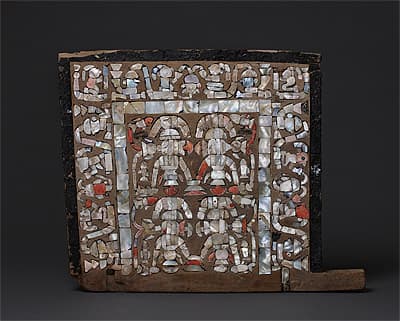
CHIMÚ culture North 1100 – 1470 AD
Backrest of a litter 1100-1470 AD wood, mother-of-pearl, chrysocolla, spondylus41.0 (h) x 50.1 (w) x 3.0 (d) cm Universidad Nacional de Trujillo Museo de Arqueología, Antropología e Historia, Trujillo Photograph: Daniel Giannoni
Men carried royalty in ceremonial chairs, known as litters, holding two poles attached to a flat platform. The backrest of a small litter found at Chan Chan was probably intended for a child or effigy figure. Mosaic inlay of precious stones, shells and sometimes gold and silver was attached using a natural resin. Not all materials were local: the red Pacific spiny oyster, Spondylus princeps—highly valued by ancient Peruvian cultures from the Chavín onwards—was traded from Ecuador.
Men carried royalty in ceremonial chairs, known as litters, holding two poles attached to a flat platform. The backrest of a small litter found at Chan Chan was probably intended for a child or effigy figure. Mosaic inlay of precious stones, shells and sometimes gold and silver was attached using a natural resin. Not all materials were local: the red Pacific spiny oyster, Spondylus princeps—highly valued by ancient Peruvian cultures from the Chavín onwards—was traded from Ecuador.
Men carried royalty in ceremonial chairs, known as litters, holding two poles attached to a flat platform. The backrest of a small litter found at Chan Chan was probably intended for a child or effigy figure. Mosaic inlay of precious stones, shells and sometimes gold and silver was attached using a natural resin. Not all materials were local: the red Pacific spiny oyster, Spondylus princeps—highly valued by ancient Peruvian cultures from the Chavín onwards—was traded from Ecuador.

